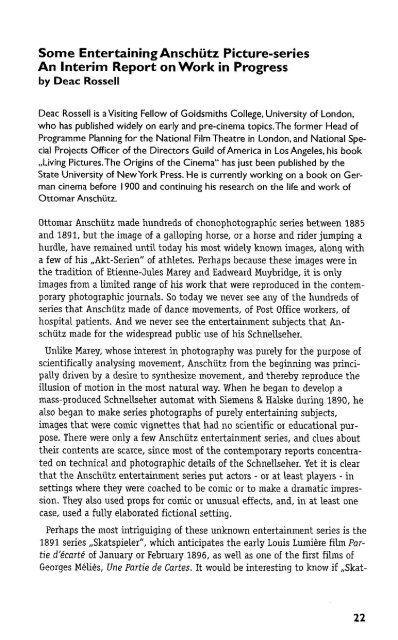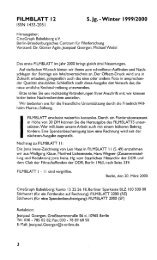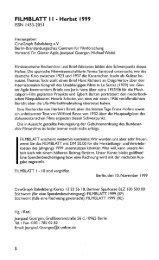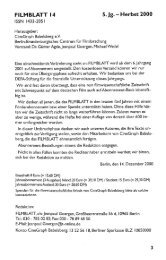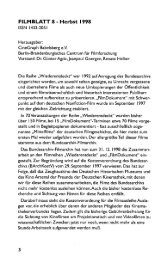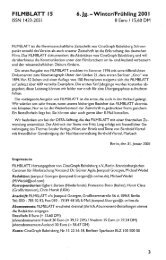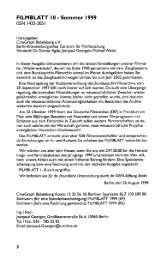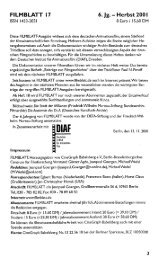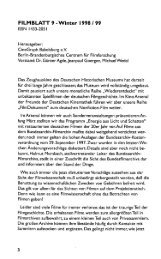Frühling/ Sommer 1998 - Filmblatt
Frühling/ Sommer 1998 - Filmblatt
Frühling/ Sommer 1998 - Filmblatt
Sie wollen auch ein ePaper? Erhöhen Sie die Reichweite Ihrer Titel.
YUMPU macht aus Druck-PDFs automatisch weboptimierte ePaper, die Google liebt.
Some EntertainingAnschütz Picture-series<br />
An Interim Report onWork in Progress<br />
by Deac Rosseil<br />
Deac Rossell is aVisiting Fellow of Goldsmiths College, University of London,<br />
who has published widely on early and pre-cinema topics.The former Head of<br />
Programme Planningforthe National FilmTheatre in London,and National Spe¬<br />
cial Projects Officer of the DirectorsGuild ofAmerica in Los Angeles, his book<br />
„Living Pictures.The Origins of the Cinema" has just been published by the<br />
State University of New York Press. He is currently working on a book on German<br />
cinema before 1900 and continuing his research on the life and work of<br />
Ottomar Anschütz.<br />
Ottomar Anschütz made hundieds of chonophotographic series between 1885<br />
and 1891, but the image of a galloping horse, or a horse and riderjumping a<br />
hurdle, have remained until today his mostwidely known images, along with<br />
a few of his „Akt-Serien"of athletes. Perhaps because these images were in<br />
the tradition of Etienne-JulesMarey and Eadweard Muybridge, it is only<br />
images from a limited ränge of his work that were reproduced in the contemporary<br />
photographic Journals. So today we never see any of the hundreds of<br />
series that Anschütz made of dance movements, of Post Office workers, of<br />
hospital patients. And we never see the entertainment subjects that An¬<br />
schütz made for the widespread public use of his Schnellseher.<br />
Unlike Maiey, whose interest in photography was purely for the purpose of<br />
scientificallyanalysing movement,Anschütz from the beginning was principally<br />
drivenby a desire to synthesizemovement, and thereby reproduce the<br />
illusion of motion in the most natural way. When he began to develop a<br />
mass-produced Schnellseherautomat with Siemens & Halske during 1890, he<br />
also began to make series photographs of purely entertaining subjects,<br />
images that were comic vignettesthat had no scientific or educationalpur¬<br />
pose. There were only a few Anschütz entertainment series, and clues about<br />
their contents are scarce, since most of the contemporary reports concentra-<br />
ted on technical and photographic details of the Schnellseher. Yet it is clear<br />
that the Anschütz entertainment series put actors -<br />
or<br />
at least players -<br />
settings where they were coached to be comic or to make a dramatic impression.<br />
They also used props for comic or unusual effects, and, in at least one<br />
case, used a fully elaborated fictional setting.<br />
Perhaps the most intriguiging of these unknown entertainment series is the<br />
1891 series „Skatspieler", which anticipates the early Louis Lumiere film Par¬<br />
tie d'ecarte of January or February 1896, as well as one of the first films of<br />
Georges Melies, Une Partie de Cartes. It would be interesting to know if „Skat-<br />
in<br />
22


